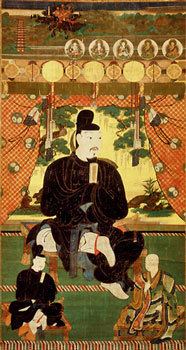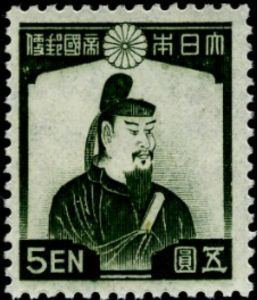Native name 藤原 鎌足 Name Fujiwara Kamatari Children Fujiwara no Fuhito Spouse(s) Kagami no Okimi Parents Nakatomi no Mikeko | Died 669 AD, Yamato Province Role Japanese statesman | |
 | ||
Full Name Nakatomi no Kamatari Known for Founder of the Fujiwara clan, launched the Taika Reform of 645 with Naka no Oe (later Emperor Tenji) Notable work Poems in the Man'yoshu and Kakyo Hyoshiki Grandchildren Empress Komyo, Fujiwara no Fusasaki, Fujiwara no Umakai, Fujiwara no Muchimaro, Fujiwara no Maro Great grandchildren Empress Koken, Fujiwara no Momokawa Similar People | ||
Fujiwara no Kamatari (藤原 鎌足, 614 – November 14, 669) was a Japanese statesman, courtier and politician during the Asuka period (538–710). Kamatari was born to the Nakatomi clan and became the founder of the Fujiwara clan. He, along with the Mononobe clan, was a supporter of Shinto and fought the introduction of Buddhism to Japan. The Soga clan, defenders of Buddhism in the Asuka period, defeated Kamatari and the Mononobe clan and Buddhism became the dominant religion of the imperial court. Kamatari, along with Prince Naka no Ōe, later Emperor Tenji (626–672), launched the Taika Reform of 645, which centralized and strengthened the central government. Just before his death he received the honorific of Taishōkan (or Daishokukan) and the surname Fujiwara from the Emperor Tenji, thus establishing the Fujiwara clan.
Contents

Biography

Kamatari was born to the Nakatomi clan, was the son of Nakatomi no Mikeko, and named Nakatomi no Kamatari (中臣 鎌足) at birth. He was a friend and supporter of the Prince Naka no Ōe, later Emperor Tenji. Kamatari was the head of the Jingi no Haku, or Shinto ritualists; as such, he was one of the chief opponents of the increasing power and prevalence of Buddhism in the court, and in the nation. As a result, in 645, Prince Naka no Ōe and Kamatari made a coup d'état in the court. They slew Soga no Iruka who had a strong influence over Empress Kōgyoku; thereafter, Iruka's father, Soga no Emishi, committed suicide.
Empress Kōgyoku was forced to abdicate in favor of her younger brother, who became Emperor Kōtoku; Kōtoku then appointed Kamatari naidaijin (内大臣, Inner Minister).
Kamatari was a leader in the development of what became known as the Taika Reforms, a major set of reforms based on Chinese models and aimed at strengthening Imperial power. He acted as one of the principal editors responsible for the development of the Japanese legal code known as Sandai-kyaku-shiki, sometimes referred to as the Rules and Regulations of the Three Generations.
During his life Kamatari continued to support Prince Naka no Ōe, who became Emperor Tenji in 661. Tenji granted him the highest rank Taishōkan (or Daishokukan) (大織冠) and a new clan name, Fujiwara (藤原), as honors.
Legacy
Kamatari's son was Fujiwara no Fuhito. Kamatari's nephew, Nakatomi no Omimaro became head of Ise Shrine, and passed down the Nakatomi name.
In the 13th century, the main line of the Fujiwara family split into five houses: Konoe, Takatsukasa, Kujō, Nijō and Ichijō. These five families in turn provided regents for the Emperors, and were thus known as the Five Regent Houses. The Tachibana clan (samurai) also claimed descent from the Fujiwara. Emperor Montoku of the Taira clan was descended through his mother to the Fujiwara.
Until the marriage of the Crown Prince Hirohito (posthumously Emperor Shōwa) to Princess Kuni Nagako (posthumously Empress Kōjun) in January 1924, the principal consorts of emperors and crown princes had always been recruited from one of the Sekke Fujiwara. Imperial princesses were often married to Fujiwara lords - throughout a millennium at least. As recently as Emperor Shōwa's third daughter, the late former Princess Takanomiya (Kazoku), and Prince Mikasa's elder daughter, the former Princess Yasuko, married into Takatsukasa and Konoe families, respectively. Empress Shōken was a descendant of the Fujiwara clan and through Hosokawa Gracia of the Minamoto clan. Likewise a daughter of the last Tokugawa Shogun married a second cousin of Emperor Shōwa.
Among Kamatari's descendants are Fumimaro Konoe the 34th/38th/39th Prime Minister of Japan and Konoe's grandson Morihiro Hosokawa the 79th Prime Minister of Japan (who is also a descendant of the Hosokawa clan via the Ashikaga clan of the Minamoto clan).
